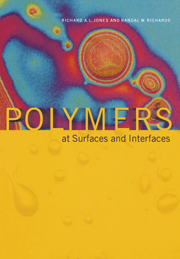Book contents
- Frontmatter
- Contents
- Preface
- 1 Introduction and overview
- 2 The surface of a simple polymer melt
- 3 Experimental techniques
- 4 Polymer/polymer interfaces
- 5 Adsorption and surface segregation from polymer solutions and mixtures
- 6 Tethered polymer chains in solutions and melts
- 7 Adhesion and the mechanical properties of polymer interfaces at the molecular level
- 8 Polymers spread at air/liquid interfaces
- Index
8 - Polymers spread at air/liquid interfaces
Published online by Cambridge University Press: 19 January 2010
- Frontmatter
- Contents
- Preface
- 1 Introduction and overview
- 2 The surface of a simple polymer melt
- 3 Experimental techniques
- 4 Polymer/polymer interfaces
- 5 Adsorption and surface segregation from polymer solutions and mixtures
- 6 Tethered polymer chains in solutions and melts
- 7 Adhesion and the mechanical properties of polymer interfaces at the molecular level
- 8 Polymers spread at air/liquid interfaces
- Index
Summary
Introduction
Polymers spread at the interface between two fluid media are of importance in a number of areas, liquid— liquid extraction, stabilisation of emulsions and as model membrane systems being some examples. By far the most extensive body of work reported has been for cases in which one of the fluid media is air, the liquid phase generally being water. Polymers spread at the air/water interface can be viewed as pseudo-two-dimensional systems; thus there is fundamental interest in ascertaining whether theory can be adapted to explain the observations. One practical advantage of spread polymer films is that film compression leads to an increase in surface concentration, so it is relatively easy to change this quantity experimentally.
Surface pressure isotherms: classification, theory and scaling laws
The surface pressure (π) is the difference in surface tension between that of the pure sub-phase liquid surface and that when the surface is covered by a film. Surface pressure isotherms for materials of low relative molecular mass are values of π plotted as a function of the area of surface available per molecule. For spread films of materials of low relative molecular mass, the surface pressure isotherm may display a number of transitions as the area available is decreased.
- Type
- Chapter
- Information
- Polymers at Surfaces and Interfaces , pp. 317 - 372Publisher: Cambridge University PressPrint publication year: 1999
- 1
- Cited by



